This article dives into effective autism grounding techniques that parents can easily implement to support their children with autism. It highlights the importance of personalized strategies, like the 5-4-3-2-1 technique, mindfulness exercises, and establishing routines. These approaches are backed by evidence showing that tailored methods can truly enhance emotional regulation and overall well-being for children on the spectrum.
Let’s explore this together! Imagine using the 5-4-3-2-1 technique during a moment of anxiety—it's all about grounding your child in the present. Mindfulness exercises can also be a fun way to connect, helping them focus and feel more secure. Establishing routines? That’s like giving your child a comforting roadmap for their day!
Remember, every child is unique, and what works for one might not work for another. So, don’t hesitate to try different strategies to find what resonates best with your little one. We’re here to help you every step of the way, and together, we can create a supportive environment that nurtures their growth and happiness!
Navigating the complexities of autism can feel like a daunting journey for parents, who are often on the lookout for effective strategies to support their children during overwhelming moments. Grounding techniques have become vital tools, offering a pathway to emotional regulation and a sense of calm. But with so many options available, how can parents find the most effective methods tailored to their child's unique needs?
In this article, we’ll delve into ten personalized grounding techniques that not only empower parents but also enhance their children's ability to manage anxiety and navigate their emotions. Let’s explore this together! We’re here to help you every step of the way!
Rori Care - ABA Therapy emphasizes the importance of personalized foundational methods in ABA therapy. Every child with autism has unique needs, so it’s essential to tailor support strategies just for them. By understanding a young person’s specific triggers and preferences, parents can use techniques that truly resonate, creating a sense of safety and calm. This personalized approach not only enhances autism grounding techniques but also allows parents to be actively involved in their child’s therapeutic journey.
Our program development service is all about crafting individualized plans that set clear, measurable goals for behavior change and skill development. Research shows that personalized therapy plans, created through thorough assessments, greatly boost engagement and progress, leading to better emotional regulation and social interactions. Plus, having skilled behavior analysts on board ensures that our approaches are grounded in evidence-based practices, improving outcomes for every child. Regular assessment and adjustments to these plans are key to meeting each individual’s evolving needs and ensuring ongoing progress.
Experts agree that family involvement plays a crucial role in enhancing autism grounding techniques. It provides practical ways to support development at home. Caregiver education is vital, equipping caregivers with the knowledge and skills to make informed choices that positively impact their child’s progress. The active participation of Registered Behavior Technicians (RBTs) in implementing these strategies enriches the therapeutic experience even further. Customizing foundational methods to fit each child’s unique profile is essential for unlocking their potential and ensuring meaningful progress in therapy. Let’s explore this together!
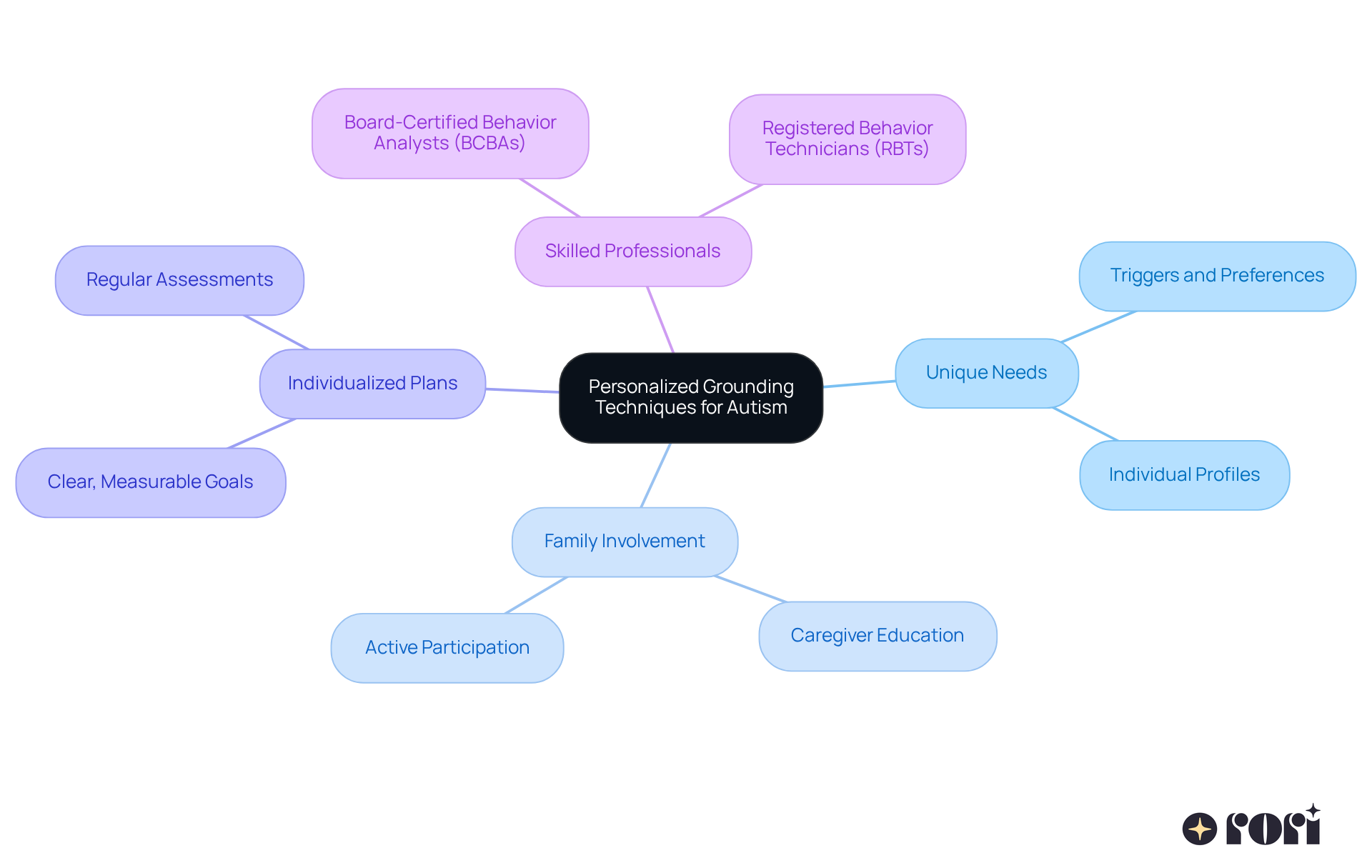
The 5-4-3-2-1 technique is a fun sensory exercise that is one of the autism grounding techniques helping kids connect with their surroundings. It encourages them to identify:
This method utilizes autism grounding techniques to effectively shift focus away from overwhelming feelings and back to the present moment. Plus, it aligns perfectly with the principles of Applied Behavior Analysis (ABA), which emphasize personalized strategies, such as autism grounding techniques, for each child’s unique needs. Parents can make this exercise playful and engaging, turning it into a delightful activity that enhances their child's awareness of the world around them.
By actively participating in these practices, caregivers not only help their children manage emotions but also acquire valuable ABA strategies, such as autism grounding techniques, that enhance their ability to encourage positive behaviors. Educating caregivers is crucial here, as it empowers parents to make informed choices and implement effective strategies for better behavioral outcomes.
To make the most of the autism grounding techniques, parents can weave the 5-4-3-2-1 technique into their daily routines. Whether during walks or mealtimes, practicing autism grounding techniques reinforces their child's sensory awareness and emotional regulation skills. Let’s explore this together and see how it can make a difference in your family's experience!
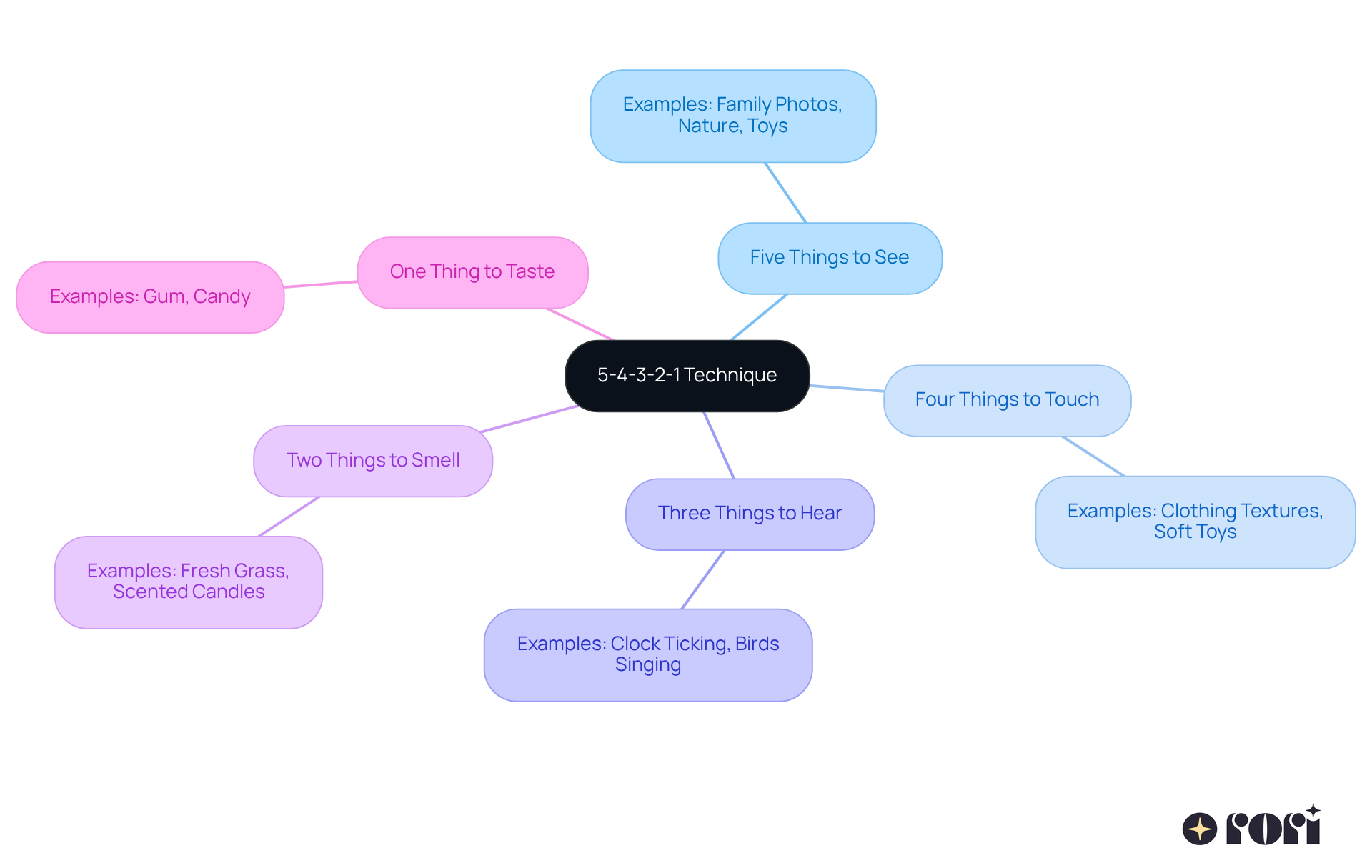
Mindfulness exercises, like guided imagery and body scans, can be wonderful tools for helping kids with autism find a sense of calm and presence. Parents, equipped with insights from caregiver education programs, can easily involve their children in these practices. For instance, guiding them to focus on their breath or to imagine a peaceful beach or a tranquil forest can be quite effective. This education not only boosts their confidence in providing support at home but also complements professional interventions, promoting consistency in care.
When these methods are practiced regularly, they can significantly enhance emotional control. Kids learn to navigate their feelings more efficiently! Research has shown that mindfulness can lead to a notable decrease in anxiety levels, providing children with essential autism grounding techniques for those stressful moments. Many young ones who practice guided imagery often share that they feel more balanced and less stressed, which helps them gain a stronger grip on their emotions.
Additionally, body scans encourage kids to tune into their physical sensations, fostering a sense of awareness and acceptance of their feelings. By weaving these mindfulness practices into daily routines, parents can equip their children with valuable skills to manage anxiety and improve their overall emotional health. This ultimately leads to better behavioral outcomes. So, let’s explore this together and see how these simple practices can make a big difference in your family’s life!
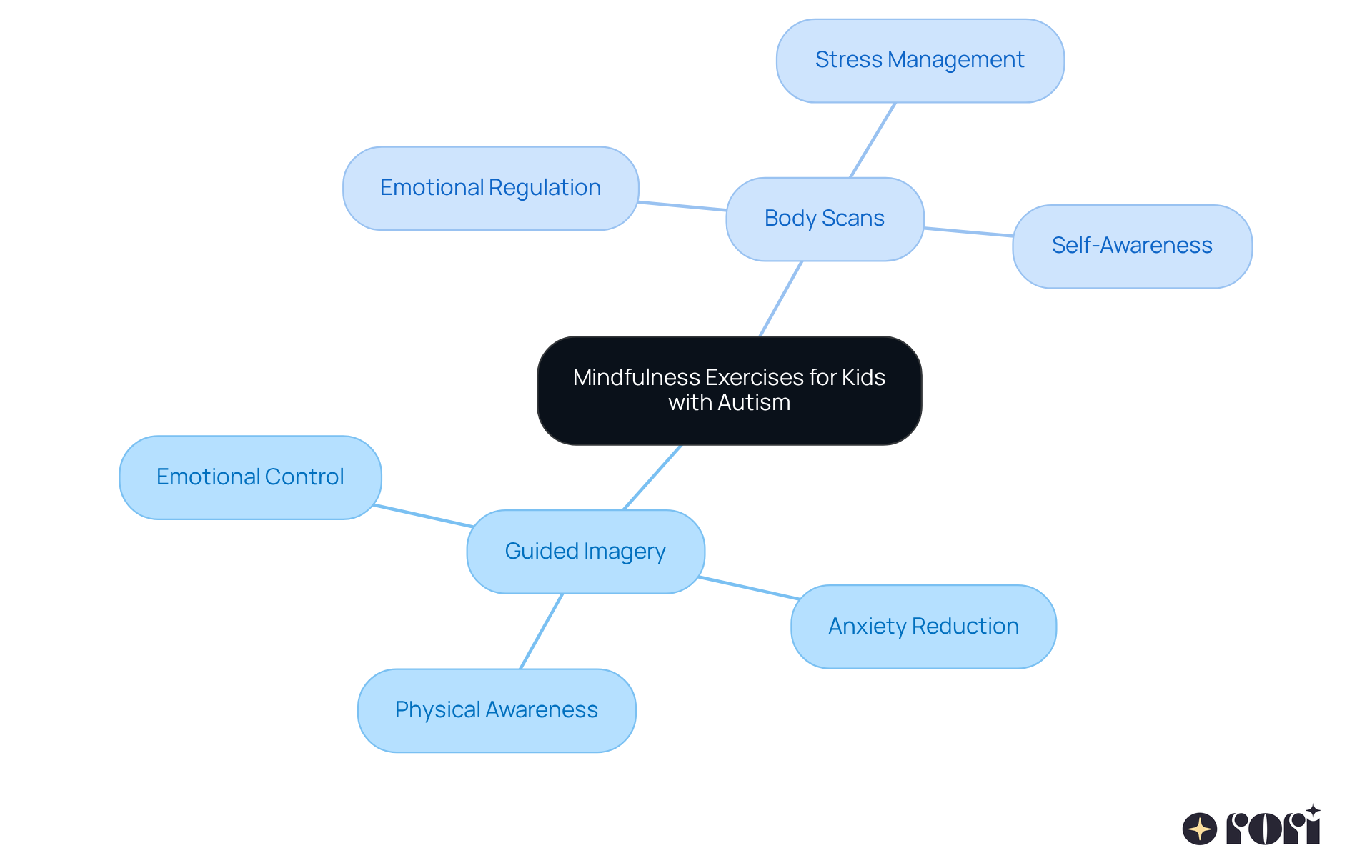
Deep breathing methods, like the 'inhale for four counts, hold for four counts, and exhale for four counts' approach, can serve as wonderful autism grounding techniques for kids. Did you know that nearly 50% of autistic individuals experience significant anxiety often? Plus, around 40% of youth with ASD are diagnosed with at least one coexisting anxiety disorder. This really highlights how crucial effective anxiety management is!
By showing your child this technique, you can help them practice it during stressful moments. Focusing on their breath not only helps them relax but also boosts their concentration, serving as one of the effective autism grounding techniques! To make breath awareness more tangible, try using small items like feathers or tissues. This way, your child can see how their breath moves these objects, making it a fun learning experience.
With consistent practice, deep breathing can stimulate the parasympathetic nervous system, soothing the body's stress response. Ultimately, utilizing autism grounding techniques can enhance emotional regulation and overall well-being for individuals on the spectrum. Let’s explore this together and see how these simple techniques can make a difference in your child’s life!
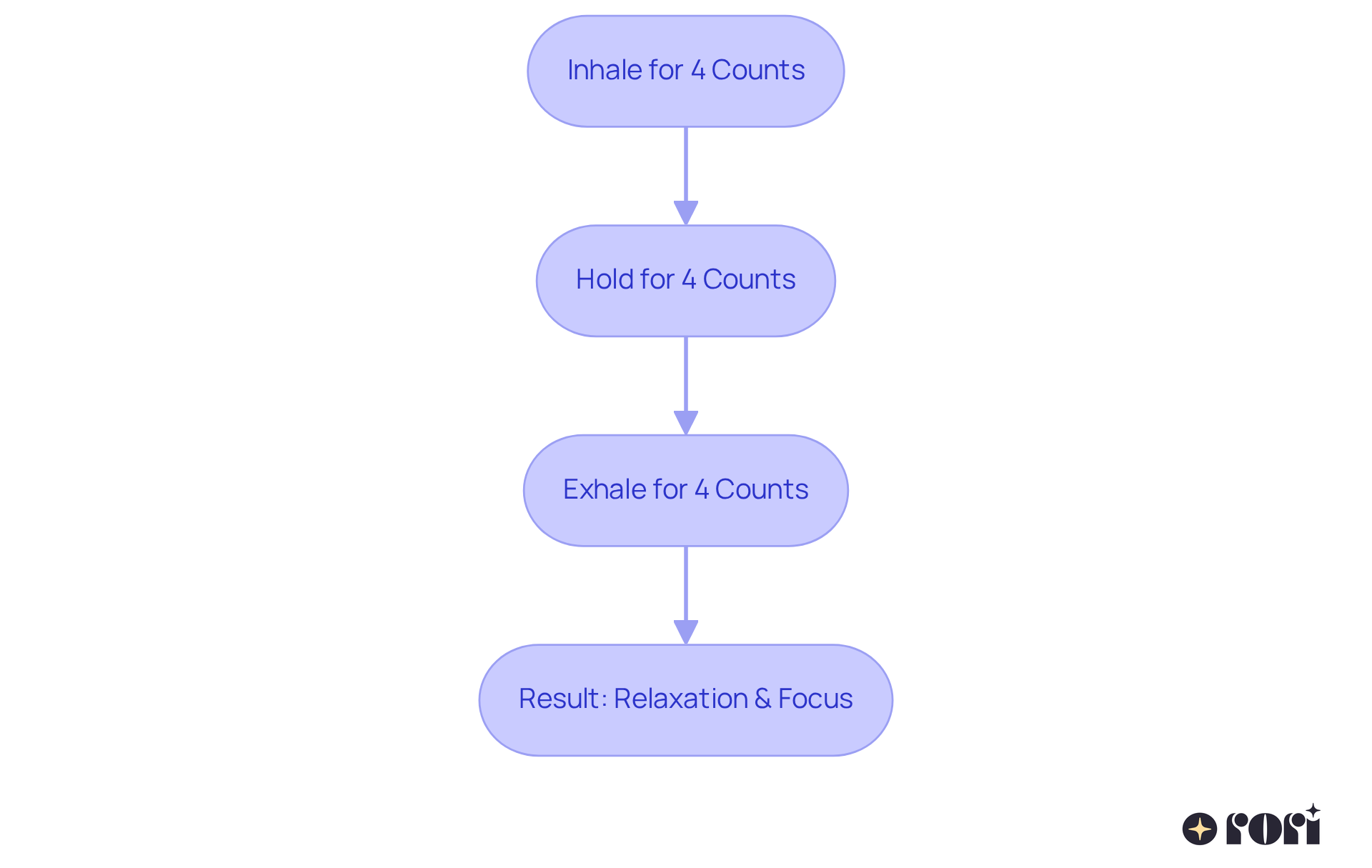
Creating a calm-down area at home can be a wonderful way for kids to utilize autism grounding techniques and find their own little refuge when things get overwhelming. Imagine a cozy space filled with soft pillows, sensory toys, and soothing visuals that really cater to what your child enjoys. Studies show that autism grounding techniques, when used in safe spaces, can significantly enhance mood regulation, allowing kids to self-soothe and regain control during tough moments.
By encouraging your little ones to use this calming atmosphere, you’re not just helping them feel better; you’re also promoting their independence and resilience. It's all about providing them with autism grounding techniques to manage their emotions effectively. Plus, adding comforting items like weighted blankets and calming scents can really enhance their experience, making this area an essential part of nurturing their emotional well-being. Let’s explore this together and see how we can create that perfect space for your child!
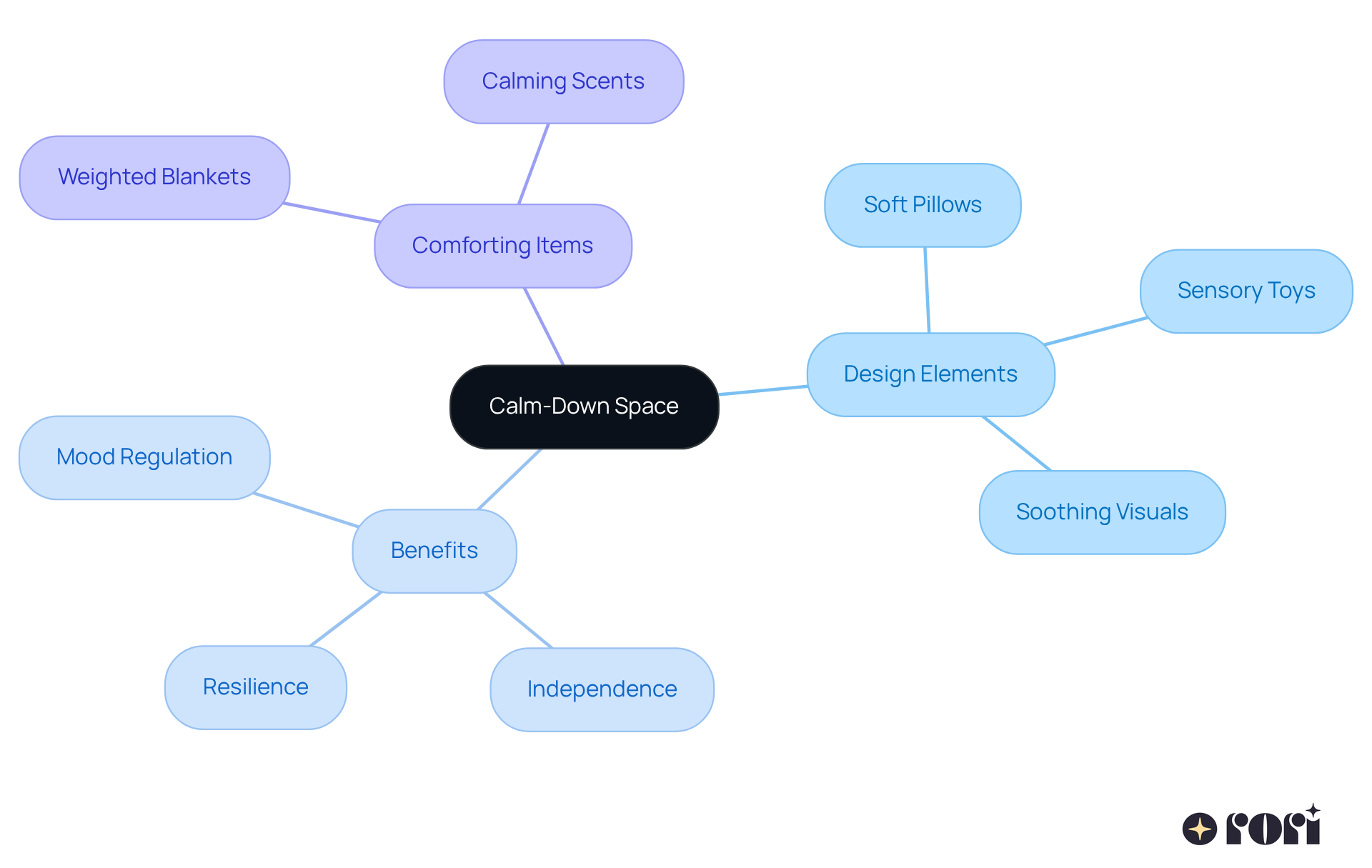
Sensory items like stress balls, fidget spinners, or textured fabrics can really help youngsters with autism grounding techniques find their footing, especially when incorporated into an Applied Behavior Analysis (ABA) therapy setting. Imagine this: parents can bring these items into therapy sessions or have them at home, encouraging their kids to reach for them when those anxious feelings creep in. By engaging with these sensory tools, children can use autism grounding techniques to redirect their focus and foster a sense of calm, which is essential for their learning and behavioral development.
This approach not only supports immediate emotional regulation but also integrates autism grounding techniques while fitting perfectly with the principles of ABA. It empowers caregivers to apply effective strategies that bolster their child's overall well-being. And here’s something to consider: studies show that when recommended hours of ABA therapy are fully implemented with active caregiver involvement, a whopping 90% of kids show significant progress! Plus, it’s worth noting that ABA therapy is the only scientifically validated treatment for autism that insurance covers, making it an essential resource for families looking for support.
Let’s explore this together! By incorporating sensory items into your routine, you can create a nurturing environment that encourages growth and connection. We’re here to help you every step of the way!
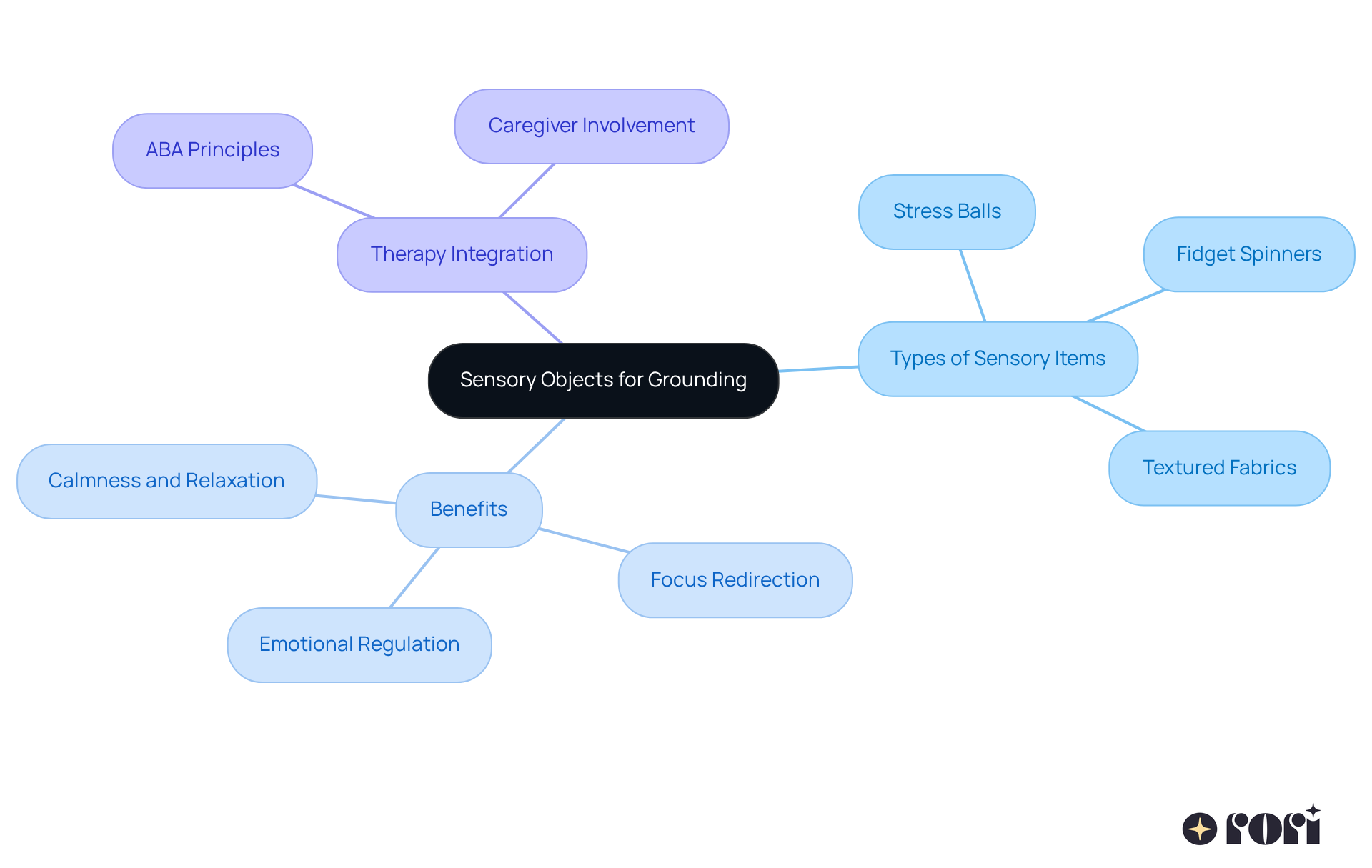
Engaging in physical activities like jumping, dancing, and yoga is a fantastic way for young individuals to channel their energy into autism grounding techniques. Not only do these activities allow them to express themselves physically, but they also play a crucial role in managing feelings. 🌟 Consistent participation in physical activities can significantly boost mood and reduce anxiety levels. Research even shows that organized exercise can improve social skills among youth using autism grounding techniques, with a moderate effect size of 0.50.
Yoga and dance, in particular, are great for helping kids regulate their emotions, making it easier for them to cope with stress and anxiety. By weaving these activities into their daily routines, youngsters can gain valuable tools for emotional self-regulation, leading to a greater sense of well-being and stability. Let’s explore this together and see how these joyful activities can make a difference in your child’s life!
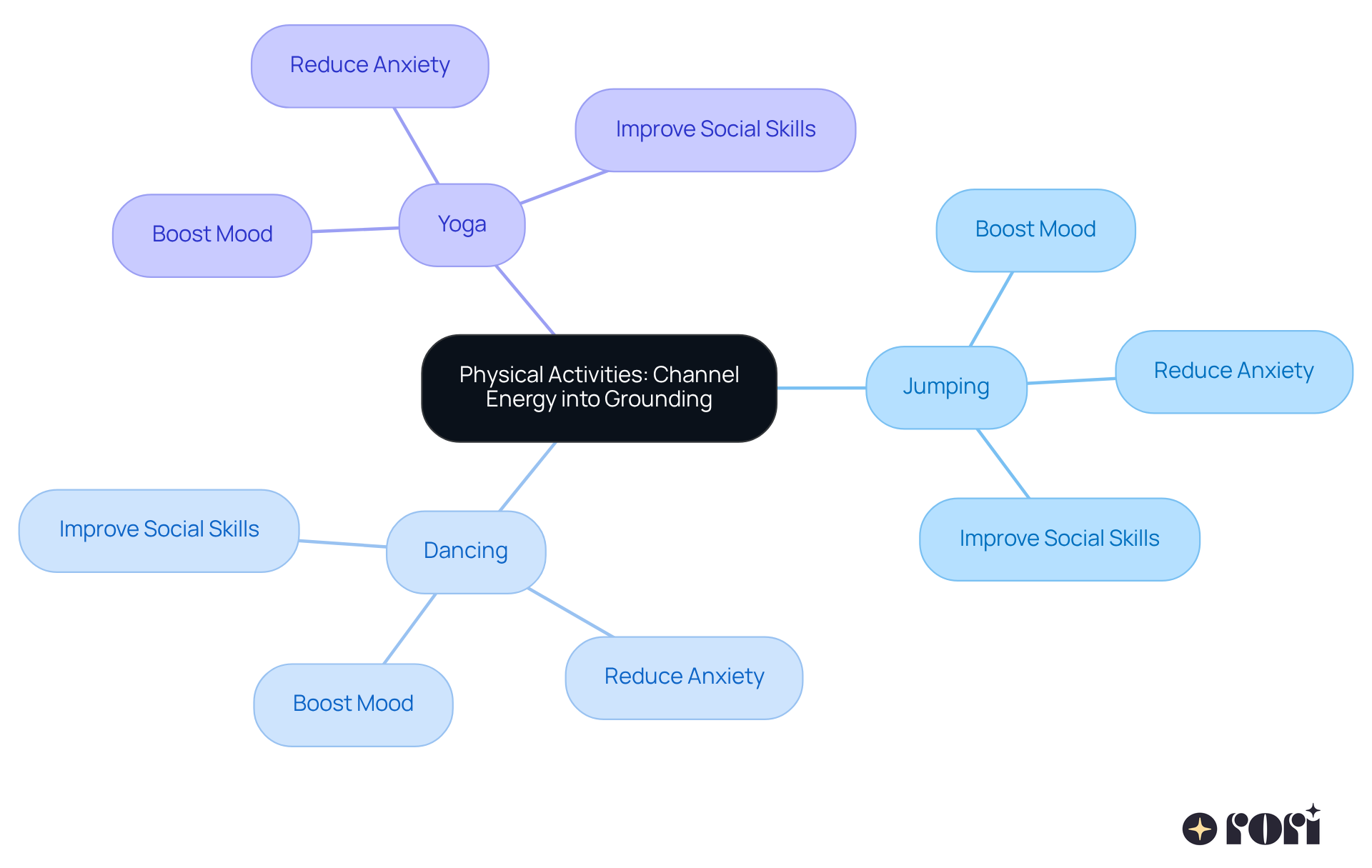
Visual aids, like schedules, charts, and visual timers, can really help create structure and predictability for individuals with autism. This aligns beautifully with the principles of Applied Behavior Analysis (ABA). By tailoring these tools to your child's unique needs, you can set up daily schedules or specific calming techniques, such as autism grounding techniques, that help them understand what to expect. This personalized approach not only reduces anxiety but also boosts their sense of security, making stabilization more effective.
Plus, ABA isn't just for kids; it supports individuals of all ages facing behavioral challenges. It empowers caregivers with strategies, such as clear visual cues, to enhance learning, verbal, and social skills. So, let’s explore this together! Your journey towards understanding and supporting your child is important, and we're here to help you every step of the way!
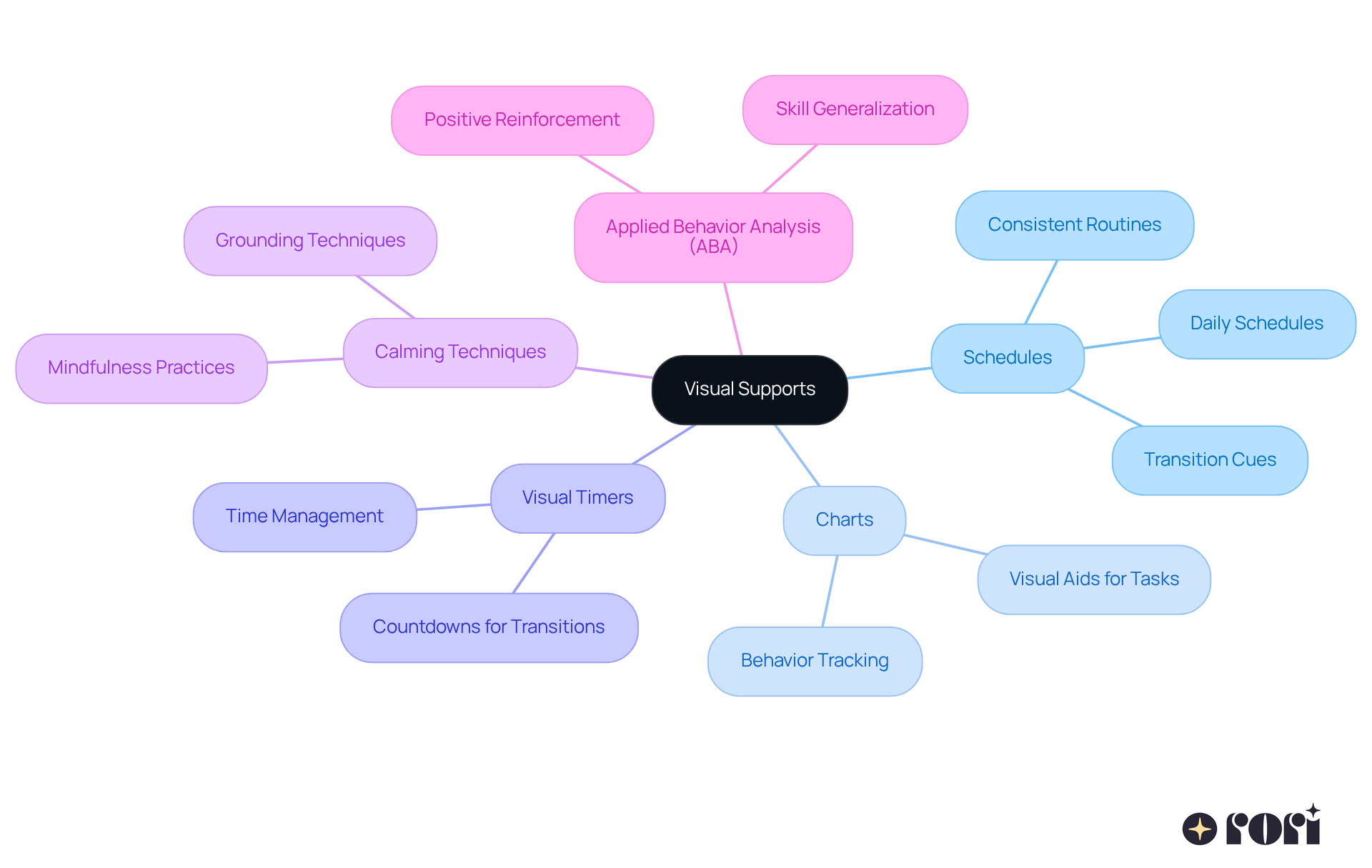
Role-playing can be a wonderful way for young individuals to practice autism grounding techniques as part of their coping strategies in safe environments. Imagine guardians setting up role-playing scenarios that mirror real-life challenges! This allows kids to try out their strategies in a nurturing setting that employs autism grounding techniques, helping them build confidence and familiarity with these methods. When stress hits, these autism grounding techniques become significantly more accessible. Let’s explore this together!
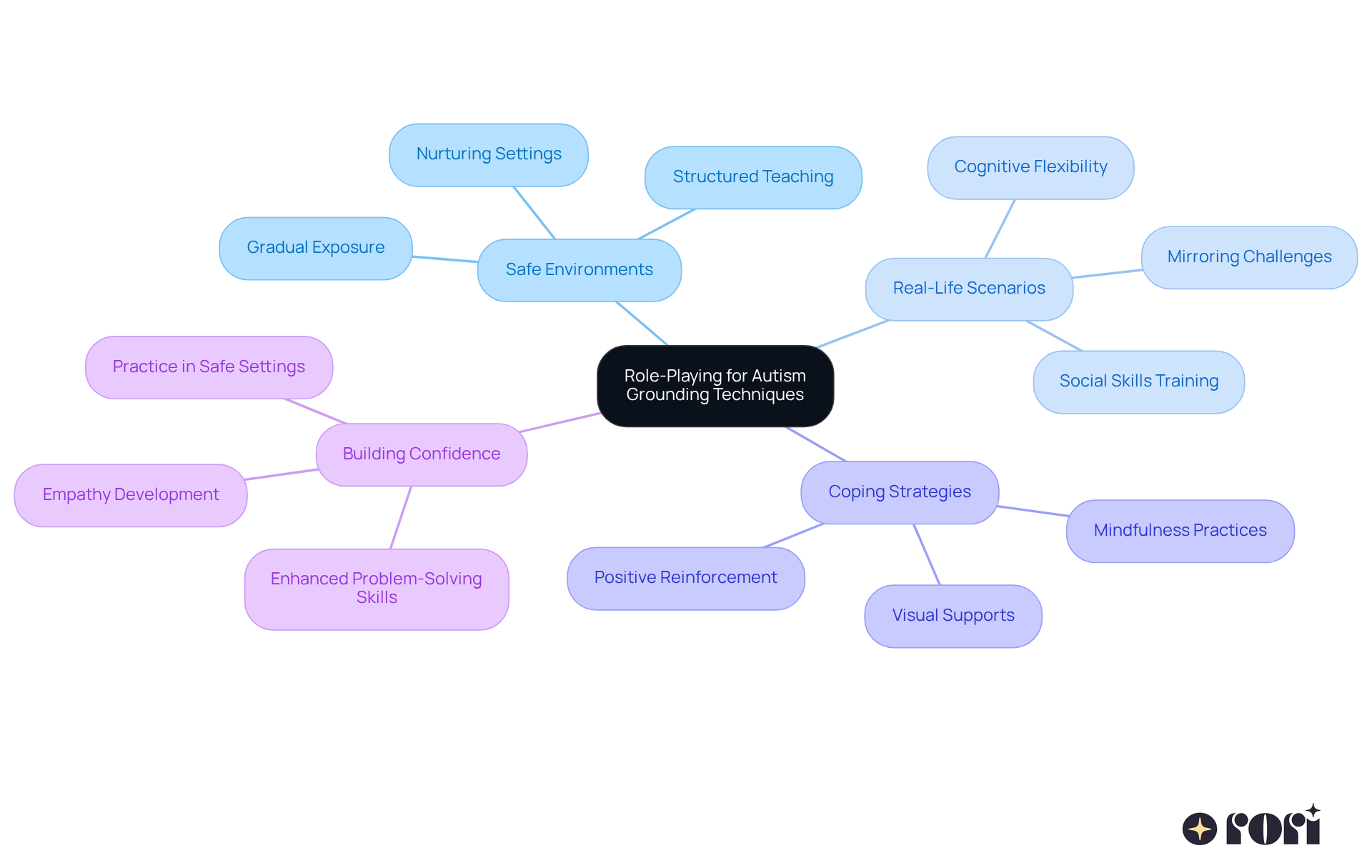
Creating regular patterns can really help our kiddos with autism grounding techniques feel more secure. By incorporating autism grounding techniques into daily routines—like setting aside specific times for mindfulness exercises or deep breathing—parents can foster a predictable environment. This predictability not only helps ease anxiety but also supports mood regulation. It makes it easier for young ones to tap into autism grounding techniques when they need them most.
Research shows that kids who stick to consistent routines often have better emotional responses. This is so important for their overall development and well-being! So, let’s explore this together and see how we can create that comforting structure for our children. We’re here to help you every step of the way!
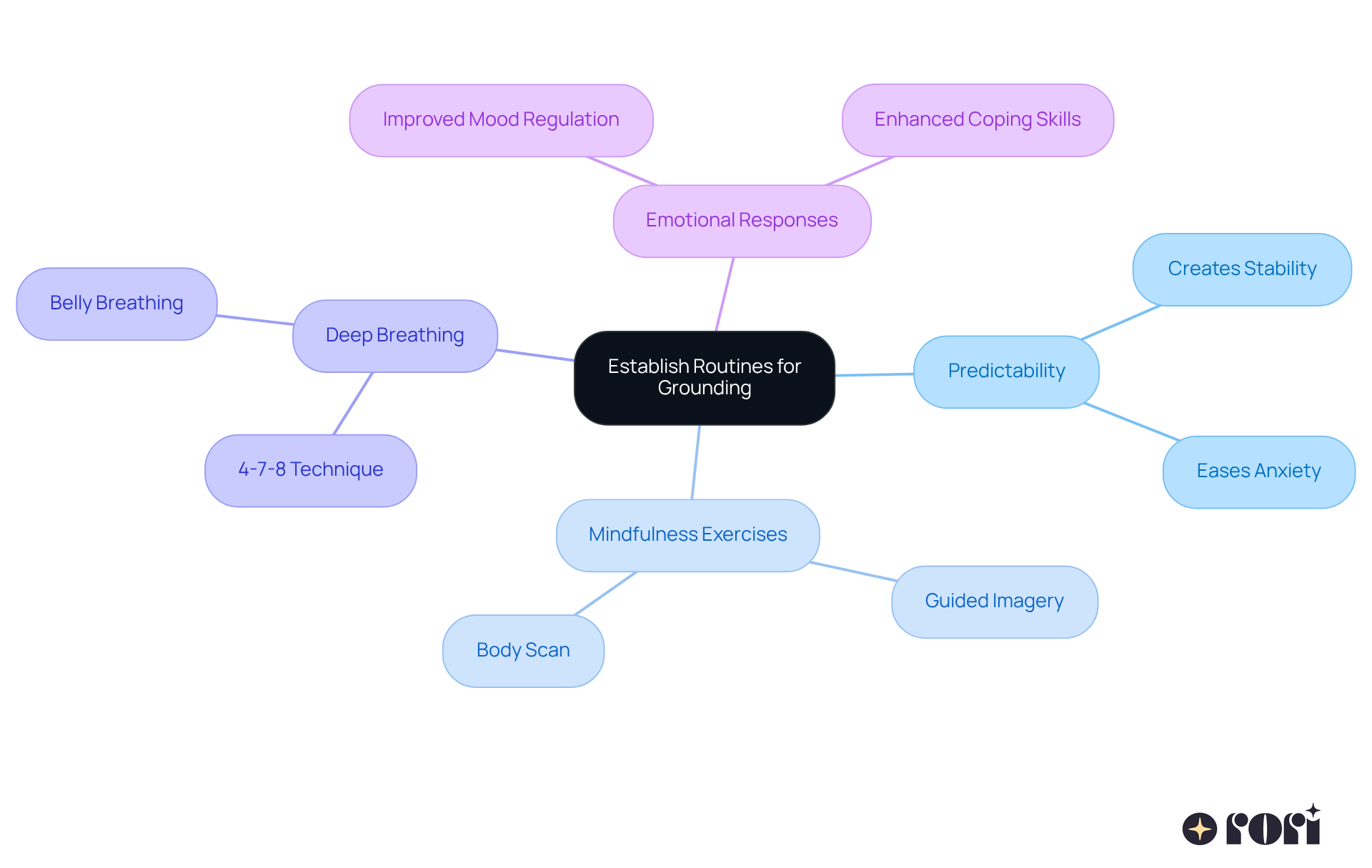
Exploring effective grounding techniques for children with autism highlights how personalized approaches can truly cater to each child's unique needs. By embracing these strategies, parents can create a nurturing environment that fosters emotional regulation and boosts their child's overall well-being. Techniques like the 5-4-3-2-1 method, mindfulness exercises, and sensory tools are essential in helping children navigate overwhelming feelings, allowing them to find a sense of calm and focus.
Key insights from the article emphasize the vital role of family involvement and caregiver education in this therapeutic journey. Techniques such as deep breathing, creating calm-down spaces, and engaging in physical activities not only empower children to manage their emotions but also promote independence and resilience. Establishing routines and utilizing visual supports further reinforce predictability, which is crucial for reducing anxiety and enhancing mood regulation.
Incorporating these grounding techniques into daily life can lead to transformative changes for children with autism. By actively engaging with these methods, parents can enhance their child's emotional health and equip them with valuable skills for navigating life's challenges. Embracing this journey together opens up wonderful opportunities for growth, connection, and a brighter future for children on the autism spectrum. Let’s explore this together!
What is the main focus of Rori Care - ABA Therapy?
Rori Care - ABA Therapy emphasizes personalized foundational methods tailored to the unique needs of each child with autism, enhancing their therapeutic journey.
How does Rori Care ensure personalized support for children with autism?
Rori Care creates individualized plans based on thorough assessments to set clear, measurable goals for behavior change and skill development, ensuring that support strategies resonate with each child's specific triggers and preferences.
Why is family involvement important in autism grounding techniques?
Family involvement enhances autism grounding techniques by providing practical ways to support development at home, and caregiver education equips them with the knowledge to positively impact their child's progress.
What is the 5-4-3-2-1 technique and how does it help children with autism?
The 5-4-3-2-1 technique is a sensory exercise that encourages children to identify five things they can see, four things they can touch, three things they can hear, two things they can smell, and one thing they can taste, helping them shift focus from overwhelming feelings to the present moment.
How can parents incorporate the 5-4-3-2-1 technique into daily routines?
Parents can weave the 5-4-3-2-1 technique into daily routines during activities like walks or mealtimes to reinforce their child's sensory awareness and emotional regulation skills.
What mindfulness exercises can benefit children with autism?
Mindfulness exercises such as guided imagery and body scans can help children find calm and presence, teaching them to focus on their breath or imagine peaceful environments.
How does regular practice of mindfulness exercises affect children with autism?
Regular practice of mindfulness exercises can significantly enhance emotional control, decrease anxiety levels, and help children better navigate their feelings.
What role does caregiver education play in implementing autism grounding techniques?
Caregiver education empowers parents with insights and strategies to support their children effectively at home, promoting consistency in care and better behavioral outcomes.